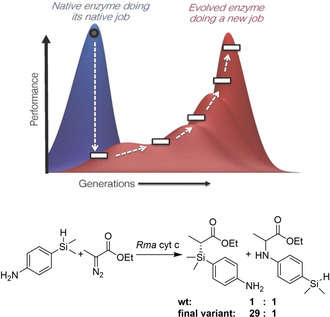Figure 16.

Top: Exploiting enzyme promiscuity to evolve new catalytic activity. Enzymes often exhibit promiscuous activity toward non‐native substrates or reactions. By applying directed evolution, a “specialist” enzyme might be transformed into another specialist enzyme for the new activity, at the cost of diminishing its original function. Such a transformation proceeds through a “low‐fitness valley” where the enzyme is not very good at either the new or the original function. Figure reproduced from ref. [93] Bottom: This concept was applied to evolve a cytochrome c from Rhodothermus marinus (without any native catalytic function) to catalyze Si−H carbene insertions. [126] The final variant was 33x more active than the parent and became more specialized for Si−H insertion over N−H insertion chemistry, both promiscuous activities of the wt.
